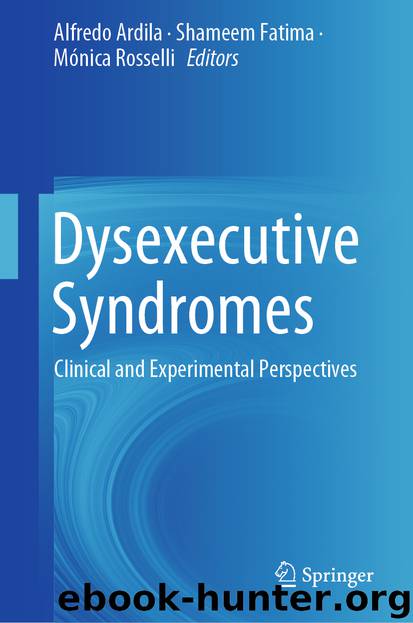Dysexecutive Syndromes by Unknown

Author:Unknown
Language: eng
Format: epub
ISBN: 9783030250775
Publisher: Springer International Publishing
8.3.2 Subcortical Disorders
ED is also present in individuals with Parkinson’s disease (PD), in which the hallmark symptoms are motor disturbances. This ED is reflected by worsened performance in several aspects of EF (e.g., set shifting, inhibitory control, reasoning, planning, and problem solving) which impacts the patients’ daily lives (Kamei et al., 2008). This dysfunction includes behavioral as well as cognitive disturbances, whose impact should be carefully assessed (Ceravolo, Pagni, Tognoni, & Bonuccelli, 2012; Gruszka, Hampshire, Barker, & Owen, 2017).
Moreover, DES has been described at the early stages of PD (Foltynie, Brayne, Robbins, & Barker, 2004) and could include deficits of working memory, planning, attentional control, and set-shifting performance. However, one of the most common deficits is set-shifting difficulties which are evident in cognitive and motor tasks. These deficits are associated with hypoactivation in the inferior frontal sulcus (IFS), the striatum, and the anterior cingulate gyrus (ACC) (Gruszka et al., 2017).
Within PD, researchers also examined the incidence of dementia and explored whether certain variables could predict cognitive decline (Williams-Gray, Foltynie, Brayne, Robbins, & Barker, 2007). Their results suggested that 10% of their patients progressed to dementia after 3.5 years, while two-thirds developed cognitive deficits in this period. They additionally described that this rate may be influenced by age, the motor phenotype, and deficits in semantic fluency and a pentagon-copying task, all of which increased the risk of progressing to dementia.
DES has also been examined in nondemented PD patients (Roussel et al., 2017). The authors reported that DES was present in 81% of PD patients, with either cognitive or behavioral impairments observed in most patients. Behaviorally, these patients often presented global hypoactivity, while cognitive impairments included deficits in inhibition and flexibility.
Download
This site does not store any files on its server. We only index and link to content provided by other sites. Please contact the content providers to delete copyright contents if any and email us, we'll remove relevant links or contents immediately.
| Automotive | Engineering |
| Transportation |
Whiskies Galore by Ian Buxton(41724)
Introduction to Aircraft Design (Cambridge Aerospace Series) by John P. Fielding(33021)
Small Unmanned Fixed-wing Aircraft Design by Andrew J. Keane Andras Sobester James P. Scanlan & András Sóbester & James P. Scanlan(32689)
Craft Beer for the Homebrewer by Michael Agnew(18086)
Turbulence by E. J. Noyes(7900)
The Complete Stick Figure Physics Tutorials by Allen Sarah(7271)
Kaplan MCAT General Chemistry Review by Kaplan(6827)
The Thirst by Nesbo Jo(6767)
Bad Blood by John Carreyrou(6481)
Modelling of Convective Heat and Mass Transfer in Rotating Flows by Igor V. Shevchuk(6358)
Learning SQL by Alan Beaulieu(6164)
Weapons of Math Destruction by Cathy O'Neil(6089)
Man-made Catastrophes and Risk Information Concealment by Dmitry Chernov & Didier Sornette(5882)
Digital Minimalism by Cal Newport;(5592)
Life 3.0: Being Human in the Age of Artificial Intelligence by Tegmark Max(5409)
iGen by Jean M. Twenge(5332)
Secrets of Antigravity Propulsion: Tesla, UFOs, and Classified Aerospace Technology by Ph.D. Paul A. Laviolette(5243)
Design of Trajectory Optimization Approach for Space Maneuver Vehicle Skip Entry Problems by Runqi Chai & Al Savvaris & Antonios Tsourdos & Senchun Chai(4961)
Electronic Devices & Circuits by Jacob Millman & Christos C. Halkias(4870)
